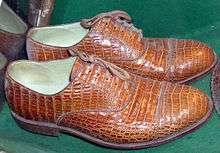shoe
See also: Shoe
English

1. Crocodile skin shoes
Etymology
From Middle English sho, shoo, from Old English sċōh (“shoe”), from Proto-Germanic *skōhaz (“shoe", literally "covering”) (compare Scots shae, West Frisian skoech, Low German Schoh, Dutch schoen, German Schuh, Danish, Norwegian and Swedish sko), from Proto-Indo-European *skewk- (compare Tocharian B skāk (“balcony”)), from *(s)kew- (“to cover”). More at sky.
Pronunciation
- IPA(key): /ʃuː/
- (General American) IPA(key): /ʃu/
Audio (US) (file) Audio (file) - Rhymes: -uː
- Homophones: shoo, shew, SHU
Noun
shoe (plural shoes or (archaic or regional) shoon)
- A protective covering for the foot, with a bottom part composed of thick leather or plastic sole and often a thicker heel, and a softer upper part made of leather or synthetic material. Shoes generally do not extend above the ankle, as opposed to boots, which do.
- Get your shoes on now, or you'll be late for school.
- A piece of metal designed to be attached to a horse's foot as a means of protection; a horseshoe.
- Throw the shoe from behind the line, and try to get it to land circling (a ringer) or touching the far stake.
- (card games) A device for holding multiple decks of playing cards, allowing more games to be played by reducing the time between shuffles.
- Something resembling a shoe in form, position, or function, such as a brake shoe.
- Remember to turn the rotors when replacing the brake shoes, or they will wear out unevenly.
- A band of iron or steel, or a ship of wood, fastened to the bottom of the runner of a sleigh, or any vehicle which slides on the snow.
- A drag, or sliding piece of wood or iron, placed under the wheel of a loaded vehicle, to retard its motion in going down a hill.
- The part of a railroad car brake which presses upon the wheel to retard its motion.
- (architecture) A trough-shaped or spout-shaped member, put at the bottom of the water leader coming from the eaves gutter, so as to throw the water off from the building.
- A trough or spout for conveying grain from the hopper to the eye of the millstone.
- An inclined trough in an ore-crushing mill.
- An iron socket or plate to take the thrust of a strut or rafter.
- An iron socket to protect the point of a wooden pile.
- (engineering) A plate, or notched piece, interposed between a moving part and the stationary part on which it bears, to take the wear and afford means of adjustment; called also slipper and gib.
- Part of a current collector on electric trains which provides contact either with a live rail or an overhead wire (fitted to a pantograph in the latter case).
- The outer cover or tread of a pneumatic tire, especially for an automobile.
Hyponyms
- See also Thesaurus:shoe
Derived terms
Related terms
Translations
protective covering for the foot
|
|
piece of metal designed to be attached to a horse’s foot — see horseshoe
something resembling a shoe (e.g. brake shoe)
- The translations below need to be checked and inserted above into the appropriate translation tables, removing any numbers. Numbers do not necessarily match those in definitions. See instructions at Wiktionary:Entry layout#Translations.
Translations to be checked
See also
Verb
shoe (third-person singular simple present shoes, present participle shoeing, simple past shod or shoed, past participle shodden or shod or shoed)
- To put shoes on one's feet.
- …men and women clothed and shod for the ascent… — Michel Potay, The Gospel Delivered in Arès, 26:6, 1995
- To put horseshoes on a horse.
- 1874— Thomas Hardy, Far from the Madding Crowd, chapter XXXII
- "Old Jimmy Harris only shoed her last week, and I'd swear to his make among ten thousand."
- 1874— Thomas Hardy, Far from the Madding Crowd, chapter XXXII
- To equip an object with a protection against wear.
- The billiard cue stick was shod in silver.
Translations
To put shoes on one's feet
to put horseshoes on a horse
|
|
to equip with protection
- The translations below need to be checked and inserted above into the appropriate translation tables, removing any numbers. Numbers do not necessarily match those in definitions. See instructions at Wiktionary:Entry layout#Translations.
Middle English
References
- “she, (pron.)” in MED Online, Ann Arbor, Mich.: University of Michigan, 2007, retrieved 9 May 2018.
This article is issued from
Wiktionary.
The text is licensed under Creative
Commons - Attribution - Sharealike.
Additional terms may apply for the media files.